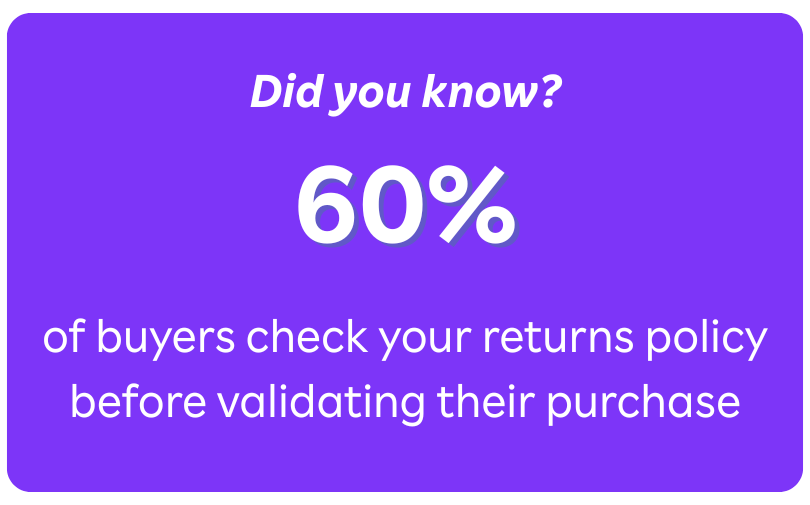E-commerce right of withdrawal: master your obligations and optimize your returns
Did you know that nearly 60% of online shoppers consult the returns policy before validating their basket? In e-commerce, managing returns and respecting the right of withdrawal are not just legal constraints: they are real issues in terms of consumer protection, customer loyalty and logistics performance. As an e-tailer, managing consumer rights properly not only enables you to avoid consumer disputes. It’s also an opportunity to reassure your customers, improve their shopping experience and turn your returns policy into a real competitive advantage.
The basics of the right of withdrawal
The right of withdrawal is the possibility for a buyer to retract and cancel a purchase made at a distance without having to provide a reason. For example, a customer who orders a jacket online can return it simply because it doesn’t fit, even if there are no defects.
This right is governed by Article L221-18 of the French Consumer Code, and is based on Directive 2011/83/EU. These texts require all professional sellers, located in France or in the European Union, to respect a legal withdrawal period.
Withdrawal period: what the law says
Customers do not need to justify their decision to cancel an order. They can use a withdrawal form or simply inform you in writing of their decision to cancel the order, along with their proof of purchase.
Key points to remember :
- The customer has a 14-day cooling-off period from receipt of the product.
- If you did not mention this right at the time of sale, this period is extended by 12 months.
- The customer must declare his or her intention to withdraw. A simple return without prior notification is not sufficient.
Please note: the right of withdrawal is distinct from the legal guarantee of conformity or hidden defects, which may apply after the 14-day period if the product has a defect.
Products concerned and exceptions
The e-commerce right of withdrawal covers the vast majority of products. However, some products are excluded, in particular
- Personalized or custom-made products.
- Perishable products.
- Unsealed audio/video recordings or software.
- Hygiene articles unsealed by the consumer after delivery (e.g. cosmetics, underwear).
- Goods that cannot be separated from other items (e.g. remote control included with a television set).
Right of withdrawal: what are your legal obligations as a seller and how do you manage your returns?
Respecting your obligations as a seller means complying with the law, avoiding consumer disputes and successfully building a relationship of trust. To improve your sales rate, you need to set up a clear, consistent and reassuring returns procedure.
Before the sale: inform and anticipate on the right of withdrawal
As an e-tailer, you have an obligation to inform your customers about :
- The existence of the right of withdrawal.
- The legal withdrawal period.
- Return conditions, including who pays the return costs.
- The refund period.
- The existence of any specific withdrawal conditions (or return policy clauses).
This information must be included in :
- Your legal notices.
- Your product sheet.
- Your seller page when selling on a marketplace.
- A clear and visible returns policy.
Further recommendations:
- Provide a simple withdrawal form, consistent with your store’s branding.
- Provide an easily accessible returns policy on all your pages.
- Explicitly state whether the customer is responsible for return shipping costs.
It’s all these little details that strengthen consumer protection… and the trust they place in your online store!
After the sale: managing withdrawals and refunds
Once you’ve received your withdrawal request, you must :
- Send an acknowledgement of receipt.
- Refund the customer within a maximum of 14 days.
Here are the rules to follow:
- The refund must cover the item, as well as standard shipping costs.
- You may withhold the refund until you have received the product or proof of shipment.
- Refunds must be made using the same payment method, unless otherwise agreed.
Please note: the right of withdrawal does not replace possible remedies for defective or non-conforming products, which are covered by other legal protection
Penalties for late refund
Penalties apply after 14 days:
- Up to 10 days: current legal interest rate
- 10 to 20 days: 5% interest
- 20 to 30 days: 10% interest
- 30 to 60 days: 20% interest
- 60 to 90 days: 50% interest
- 5 points per month thereafter (until price is doubled, then increased by the legal interest rate)
Product condition: your rights and their limits
Before granting a refund, you can assess the condition of the returned product. However, there are certain rules governing this control.
- Unwrapped product: the customer may return the product even if it has already been opened, except in the case of unsealed and hygiene-related products. The original packaging is not mandatory, but the return must be secure.
- Depreciated product: you are obliged to accept the return, but a discount may be applied if the item has been used excessively. Example: shoes worn every day for 14 days.
Return costs: a strategic point
Return costs must be an integral part of your cancellation policy. As an online retailer, you have a number of options, but there are also a number of obligations that must be met.
- By default, these costs are borne by the customer.
- If you haven’t specified this before the purchase, you must assume the cost.
- If you offer return shipping costs, this becomes a strong marketing argument to reassure customers.
Beyond obligation: turn returns management into a growth lever
Good e-commerce returns management also helps improve your customer loyalty strategy. This is where returns management comes in. Also known as “reverse logistics”, this involves organizing the return of items for inspection, restocking or recycling.
There are a few best practices for professionalizing your returns:
- Set up a simple, accessible returns procedure.
- Offer a pre-filled returns label.
- Create an automated online returns portal.
- Train your after-sales service to handle complaints, exchanges and non-conforming products, and to adopt empathetic communication.
- Outsource logistics to a specialized logistics provider.
One of the solutions on the market is Rakuten Fulfillment Network’s turnkey e-commerce logistics service. RFN supports you throughout the entire returns chain, from receipt to reintegration into stock. It’s the ideal solution for keeping your teams lean, streamlining the customer experience and focusing on your core business
The e-commerce right of withdrawal, an opportunity to be seized
Much more than a legal constraint, the e-commerce right of withdrawal is a driver of trust, transparency and differentiation. By mastering your buyer’s rights and your seller’s obligations, you can protect your business while strengthening customer loyalty. By going beyond legal minimums with a responsive after-sales service, a clear policy and well-defined return conditions, you demonstrate your seriousness. And by entrusting your returns to a solution like Rakuten Fulfillment Network, you simplify returns management, secure your flows and improve your image. At the end of the day, the right of withdrawal is not an inevitability, but a strategic opportunity



